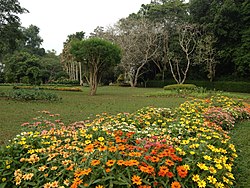Henarathgoda Botanical Garden
| Henarathgoda Botanical Garden | |
|---|---|
 | |
 | |
| Type | Botanical garden |
| Location | Gampaha, Sri Lanka |
| Coordinates | 7°06′00″N 79°59′10″E / 7.10000°N 79.98611°E |
| Area | 17.8ha |
| Elevation | 10m |
| Created | 1876[1] |
| Operated by | Department of National Botanic Gardens, Sri Lanka |
| Status | Open all year |
| Plants | 2,000 (Appx:) |
| Species | 400 (Appx:) |
| Part of a series on |
| Wildlife of Sri Lanka |
|---|
 |
Henarathgoda Botanical Garden, also known as Gampaha Botanical Garden, is one of the six botanical gardens in Sri Lanka. The botanical garden is situated on the Gampaha-Minuwangoda main road, approximately 450 m (1,480 ft) away from Gampaha railway station. It is about 29 km (18 mi) from Sri Lanka's commercial capital of Colombo.[2][3]
It was established in 1876 by the
History
In 1825
During the 19th century

In 1876, 1,919 rubber seedlings, originally collected from the Amazon forest (
The trees blossomed in 1880 and from the next year Rubber seeds were distributed throughout the country as well as some other
). Remnants of these first Rubber trees are now protected as a national monument. Forest Department, Sri Lanka(1887) was responsible for all major plant introductions for economic and environmental development in the Henarathgoda Botanical Garden.Activities that followed resulted in the development of economic and plantation crops, emergence of important state departments such as Department of Agriculture (1912) and institutions for the development of Plantation Crops such as Rubber. In 1919 the world first rubber exhibition was held at the Royal Botanical Gardens, Peradeniya.
Later the garden was developed as a standard
Original extent of gardens was about 36 acres (0.15 km2) in extent an additional 7 acres (0.03 km2) was added in 2005. It now serves as a tropical low country Botanic Garden and after the establishment of Department of national Botanic Gardens in 2006, the Henarathgoda Botanical Garden functions as a division under it.[9]
Garden
The altitude of garden is about 10 m (33 ft) above the sea level. It has a tropical low-country climate. The total area of the botanical garden is about 15 ha (37 acres) and recently it acquired another 2.8 ha (6.9 acres) for its expansion.
Visitor attraction
The newest additions to the 148-year-old botanical garden include boat rides at the Attanagalu Oya and a bridge over the river. The garden hosts an extensive collection of

Botanical research
As one of the island's most renowned institutions for conservation, the Henarathgoda Botanical Garden is also actively engaged in the development and education of the country's
Location
Henarathgoda Botanic Garden is situated about 18 miles (29 km) north-west of Colombo and within 1 kilometre (1,100 yd) from the Gampaha Railway Station, and not more than 500 yards (460 m) from the Gampaha-Minuwangoda road.[9]
See also
References
- ^ "Gampaha Botanical Garden - BGCI". Botanic Gardens Conservation International. Retrieved 14 October 2012.
- ^ "Gampaha Henarathgoda Botanical Garden - Mal Watta".
- ^ "The Government Information Center".
- ISBN 9781491713655.
- ^ "Sri Lanka Botanical Gardens". Go-Lanka.com. 2007. Retrieved 14 October 2012.
- ISBN 9781845375935.
- ^ The Gardeners Chronicle and Horticultural Trade Journal. Vol. 17. London. 1895. p. 489.
{{cite book}}: CS1 maint: location missing publisher (link) - ^ "Gampaha Botanic Garden - Botanic Gardens Conservation International".
- ^ a b "Henarathgoda Botanic Gardens - Gampaha". The Government Information Center, Sri Lanka. 4 November 2009. Retrieved 14 October 2012.
